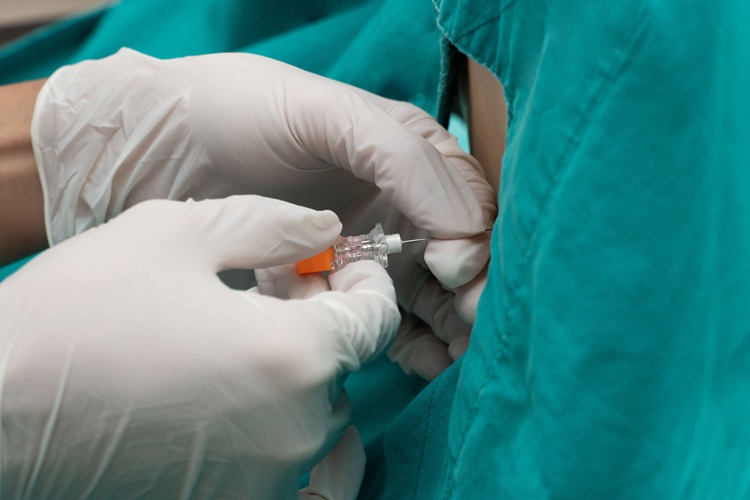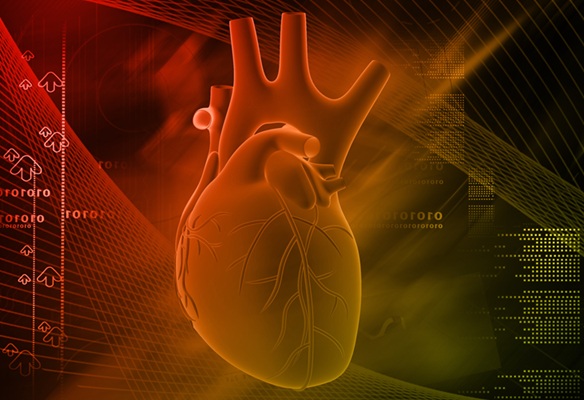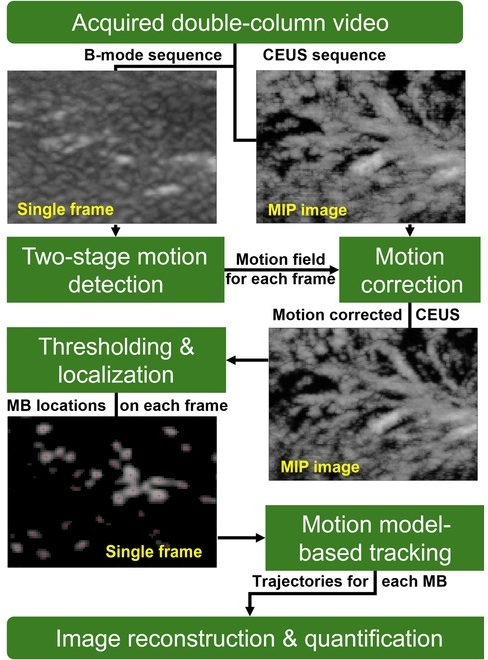Image Analysis Algorithms Devised to Find Weak Spots in Muscles, Tendons, and Bones prone to Tearing, Breaking
|
By MedImaging International staff writers Posted on 09 Sep 2014 |
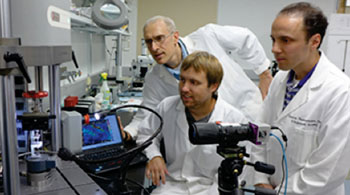
Image: From left, Guy Genin, PhD, John Boyle and Stavros Thomopoulos, PhD, watch as a sample is exposed to stress and force. They have developed algorithms that may lead to the ability to identify weak spots in tendons, muscles and bones (Photo courtesy of Washington University in St. Louis).
Researchers have developed algorithms to detect weak spots in muscles, tendons, and bones predisposed to tearing or breaking. The technology, which needs to be further refined before it is used in patients, may soon help target minor strains and tiny injuries in the body’s tissues long before greater problems occur.
The research was published online August 27, 2014, in the journal of the Royal Society Interface, which publishes research at the nexus of the physical and life sciences. “Tendons are constantly stretching as muscles pull on them, and bones also bend or compress as we carry out everyday activities,” said senior investigator Stavros Thomopoulos, PhD, professor of orthopedic surgery at Washington University in St. Louis (MO, USA). “Small cracks or tears can result from these loads and lead to major injuries. Understanding how these tears and cracks develop over time therefore is important for diagnosing and tracking injuries.”
Dr. Thomopoulos and his colleagues developed a strategy to visualize and even predict spots where tissues are weakened. To accomplish this, they pulled tissues and monitored what occurred as their shapes changed or became distorted. The study’s first author, John J. Boyle, a graduate student in biomedical engineering, combined mechanical engineering basics with image-analysis techniques to create the algorithms, which were tested in different materials and in animal models. “If you imagine stretching Silly Putty or a swimming cap with a picture on it, as you pull, the picture becomes distorted,” Dr. Boyle said. “This allows us to track how the material responds to an external force.”
In one of the experiments described in the paper, Dr. Boyle sprayed a pattern of dots on plastic wrap, stretched it and tracked the dots. “As you pull and stretch the plastic wrap, eventually tears begin to emerge,” he explained. “The new algorithm allowed us to find the places where the tears were beginning to form and to track them as they extended. Older algorithms are not as good at finding and tracking localized strains as the material stretches.”
One of the two new algorithms is 1,000 times more accurate than older approaches for quantifying very large stretches near tiny cracks and tears, the research showed. And a second algorithm has the ability to predict where cracks and failures are likely to form. “This extra accuracy is critical for quantifying large strains,” said Guy Genin, PhD, professor of mechanical engineering and co-senior investigator on the study.”
Commercial algorithms that estimate strain frequently are much less sensitive, and they are prone to identifying noise that can arise from the algorithm itself instead of from the substance being examined. The new algorithms can differentiate the noise from true regions of large strains.”
Dr. Thomopoulos, who also is a professor of biomedical engineering and of mechanical engineering, works with Dr. Genin to study the shoulder’s rotator cuff, a group of tendons and muscles that connect the upper arm to the shoulder blade. They are setting out to determine why some surgeries to repair rotator cuff injuries eventually fail. Their goal is to increase the chances that the tissue in the shoulder will heal following surgery, and they think the new algorithms could help them get closer to that objective. How soon the new algorithms could be used in patients depends on getting clearer images of the body’s tissues. Current imaging techniques, such as magnetic resonance imaging (MRI) and ultrasound do not have the required clarity and resolution.
Dr. Genin also explained that although the objective of the current study is to better determine how forces at work on human tissue cause injury and stress, the algorithms also could help engineers identify vulnerable areas of buildings and other structures. Our muscles and bones, he said, are influenced by the same strains that affect those structures. “Whether it’s a bridge or a tendon, it’s vital to understand the ways that physical forces cause structures and tissues to deform so that we can identify the onset of failures and eventually predict them,” he said.
In the long term, the investigators want to use the algorithms to prevent further injuries following surgery to repair, shoulders, knees, and other tissues. They also reported that it may be possible in the future to predict problems before they occur.
The scientists, who applied for a provisional patent earlier in 2014, hope the algorithms will be useful to researchers in the medical and engineering fields.
Related Links:
Washington University in St. Louis
The research was published online August 27, 2014, in the journal of the Royal Society Interface, which publishes research at the nexus of the physical and life sciences. “Tendons are constantly stretching as muscles pull on them, and bones also bend or compress as we carry out everyday activities,” said senior investigator Stavros Thomopoulos, PhD, professor of orthopedic surgery at Washington University in St. Louis (MO, USA). “Small cracks or tears can result from these loads and lead to major injuries. Understanding how these tears and cracks develop over time therefore is important for diagnosing and tracking injuries.”
Dr. Thomopoulos and his colleagues developed a strategy to visualize and even predict spots where tissues are weakened. To accomplish this, they pulled tissues and monitored what occurred as their shapes changed or became distorted. The study’s first author, John J. Boyle, a graduate student in biomedical engineering, combined mechanical engineering basics with image-analysis techniques to create the algorithms, which were tested in different materials and in animal models. “If you imagine stretching Silly Putty or a swimming cap with a picture on it, as you pull, the picture becomes distorted,” Dr. Boyle said. “This allows us to track how the material responds to an external force.”
In one of the experiments described in the paper, Dr. Boyle sprayed a pattern of dots on plastic wrap, stretched it and tracked the dots. “As you pull and stretch the plastic wrap, eventually tears begin to emerge,” he explained. “The new algorithm allowed us to find the places where the tears were beginning to form and to track them as they extended. Older algorithms are not as good at finding and tracking localized strains as the material stretches.”
One of the two new algorithms is 1,000 times more accurate than older approaches for quantifying very large stretches near tiny cracks and tears, the research showed. And a second algorithm has the ability to predict where cracks and failures are likely to form. “This extra accuracy is critical for quantifying large strains,” said Guy Genin, PhD, professor of mechanical engineering and co-senior investigator on the study.”
Commercial algorithms that estimate strain frequently are much less sensitive, and they are prone to identifying noise that can arise from the algorithm itself instead of from the substance being examined. The new algorithms can differentiate the noise from true regions of large strains.”
Dr. Thomopoulos, who also is a professor of biomedical engineering and of mechanical engineering, works with Dr. Genin to study the shoulder’s rotator cuff, a group of tendons and muscles that connect the upper arm to the shoulder blade. They are setting out to determine why some surgeries to repair rotator cuff injuries eventually fail. Their goal is to increase the chances that the tissue in the shoulder will heal following surgery, and they think the new algorithms could help them get closer to that objective. How soon the new algorithms could be used in patients depends on getting clearer images of the body’s tissues. Current imaging techniques, such as magnetic resonance imaging (MRI) and ultrasound do not have the required clarity and resolution.
Dr. Genin also explained that although the objective of the current study is to better determine how forces at work on human tissue cause injury and stress, the algorithms also could help engineers identify vulnerable areas of buildings and other structures. Our muscles and bones, he said, are influenced by the same strains that affect those structures. “Whether it’s a bridge or a tendon, it’s vital to understand the ways that physical forces cause structures and tissues to deform so that we can identify the onset of failures and eventually predict them,” he said.
In the long term, the investigators want to use the algorithms to prevent further injuries following surgery to repair, shoulders, knees, and other tissues. They also reported that it may be possible in the future to predict problems before they occur.
The scientists, who applied for a provisional patent earlier in 2014, hope the algorithms will be useful to researchers in the medical and engineering fields.
Related Links:
Washington University in St. Louis
Latest General/Advanced Imaging News
- First-Of-Its-Kind Wearable Device Offers Revolutionary Alternative to CT Scans
- AI-Based CT Scan Analysis Predicts Early-Stage Kidney Damage Due to Cancer Treatments
- CT-Based Deep Learning-Driven Tool to Enhance Liver Cancer Diagnosis
- AI-Powered Imaging System Improves Lung Cancer Diagnosis
- AI Model Significantly Enhances Low-Dose CT Capabilities
- Ultra-Low Dose CT Aids Pneumonia Diagnosis in Immunocompromised Patients
- AI Reduces CT Lung Cancer Screening Workload by Almost 80%
- Cutting-Edge Technology Combines Light and Sound for Real-Time Stroke Monitoring
- AI System Detects Subtle Changes in Series of Medical Images Over Time
- New CT Scan Technique to Improve Prognosis and Treatments for Head and Neck Cancers
- World’s First Mobile Whole-Body CT Scanner to Provide Diagnostics at POC
- Comprehensive CT Scans Could Identify Atherosclerosis Among Lung Cancer Patients
- AI Improves Detection of Colorectal Cancer on Routine Abdominopelvic CT Scans
- Super-Resolution Technology Enhances Clinical Bone Imaging to Predict Osteoporotic Fracture Risk
- AI-Powered Abdomen Map Enables Early Cancer Detection
- Deep Learning Model Detects Lung Tumors on CT
Channels
Radiography
view channel
Machine Learning Algorithm Identifies Cardiovascular Risk from Routine Bone Density Scans
A new study published in the Journal of Bone and Mineral Research reveals that an automated machine learning program can predict the risk of cardiovascular events and falls or fractures by analyzing bone... Read more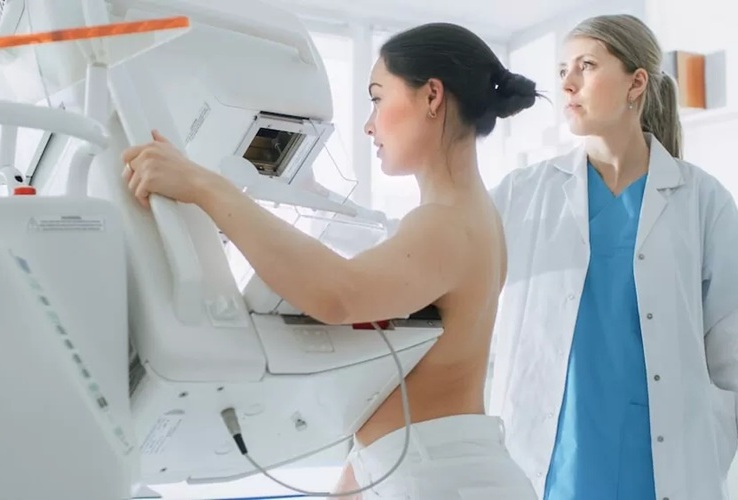
AI Improves Early Detection of Interval Breast Cancers
Interval breast cancers, which occur between routine screenings, are easier to treat when detected earlier. Early detection can reduce the need for aggressive treatments and improve the chances of better outcomes.... Read more
World's Largest Class Single Crystal Diamond Radiation Detector Opens New Possibilities for Diagnostic Imaging
Diamonds possess ideal physical properties for radiation detection, such as exceptional thermal and chemical stability along with a quick response time. Made of carbon with an atomic number of six, diamonds... Read moreMRI
view channel
New MRI Technique Reveals Hidden Heart Issues
Traditional exercise stress tests conducted within an MRI machine require patients to lie flat, a position that artificially improves heart function by increasing stroke volume due to gravity-driven blood... Read more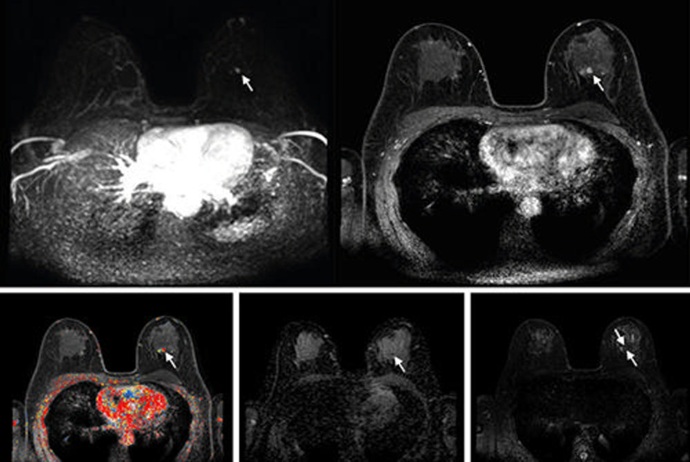
Shorter MRI Exam Effectively Detects Cancer in Dense Breasts
Women with extremely dense breasts face a higher risk of missed breast cancer diagnoses, as dense glandular and fibrous tissue can obscure tumors on mammograms. While breast MRI is recommended for supplemental... Read moreUltrasound
view channel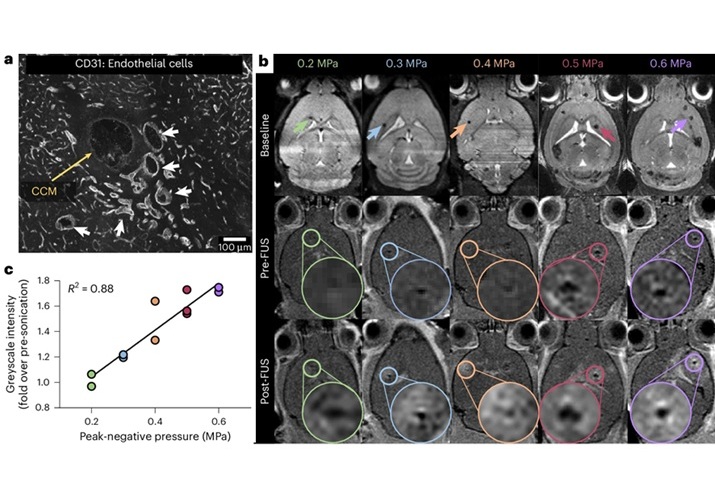
New Incision-Free Technique Halts Growth of Debilitating Brain Lesions
Cerebral cavernous malformations (CCMs), also known as cavernomas, are abnormal clusters of blood vessels that can grow in the brain, spinal cord, or other parts of the body. While most cases remain asymptomatic,... Read more.jpeg)
AI-Powered Lung Ultrasound Outperforms Human Experts in Tuberculosis Diagnosis
Despite global declines in tuberculosis (TB) rates in previous years, the incidence of TB rose by 4.6% from 2020 to 2023. Early screening and rapid diagnosis are essential elements of the World Health... Read moreNuclear Medicine
view channel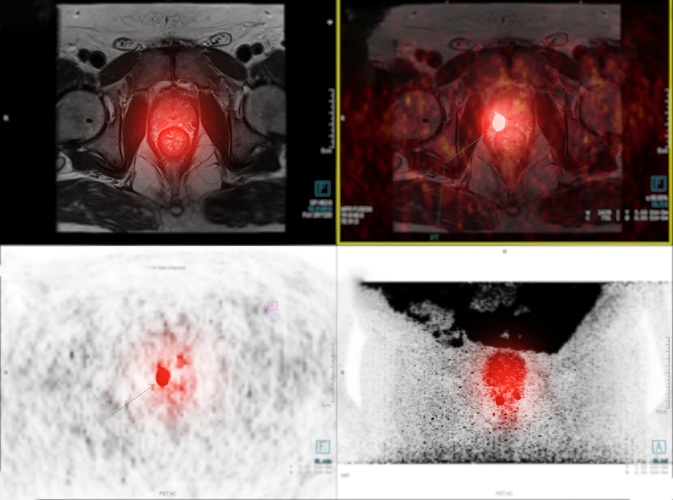
New Imaging Approach Could Reduce Need for Biopsies to Monitor Prostate Cancer
Prostate cancer is the second leading cause of cancer-related death among men in the United States. However, the majority of older men diagnosed with prostate cancer have slow-growing, low-risk forms of... Read more
Novel Radiolabeled Antibody Improves Diagnosis and Treatment of Solid Tumors
Interleukin-13 receptor α-2 (IL13Rα2) is a cell surface receptor commonly found in solid tumors such as glioblastoma, melanoma, and breast cancer. It is minimally expressed in normal tissues, making it... Read moreImaging IT
view channel
New Google Cloud Medical Imaging Suite Makes Imaging Healthcare Data More Accessible
Medical imaging is a critical tool used to diagnose patients, and there are billions of medical images scanned globally each year. Imaging data accounts for about 90% of all healthcare data1 and, until... Read more
Global AI in Medical Diagnostics Market to Be Driven by Demand for Image Recognition in Radiology
The global artificial intelligence (AI) in medical diagnostics market is expanding with early disease detection being one of its key applications and image recognition becoming a compelling consumer proposition... Read moreIndustry News
view channel
GE HealthCare and NVIDIA Collaboration to Reimagine Diagnostic Imaging
GE HealthCare (Chicago, IL, USA) has entered into a collaboration with NVIDIA (Santa Clara, CA, USA), expanding the existing relationship between the two companies to focus on pioneering innovation in... Read more
Patient-Specific 3D-Printed Phantoms Transform CT Imaging
New research has highlighted how anatomically precise, patient-specific 3D-printed phantoms are proving to be scalable, cost-effective, and efficient tools in the development of new CT scan algorithms... Read more
Siemens and Sectra Collaborate on Enhancing Radiology Workflows
Siemens Healthineers (Forchheim, Germany) and Sectra (Linköping, Sweden) have entered into a collaboration aimed at enhancing radiologists' diagnostic capabilities and, in turn, improving patient care... Read more








 Guided Devices.jpg)




